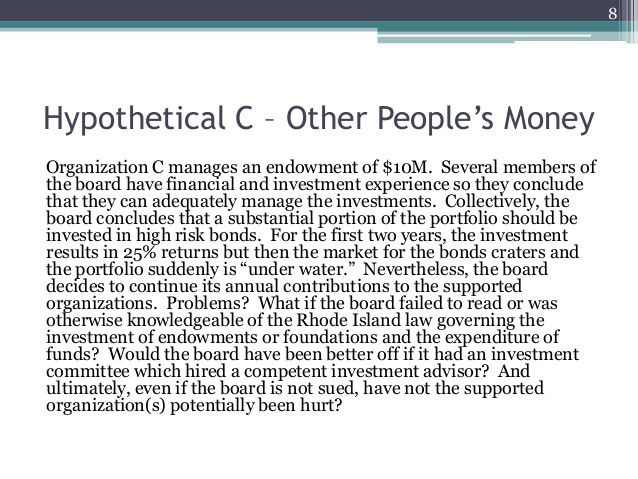Managing Nonprofit Organization Investments
Post on: 3 Июль, 2015 No Comment

By: Melanie Nichols
Investing is an inexact science, maybe even an art, but selecting appropriate investment policies and strategies for non-profit assets is not. There is a model that non-profit financial managers should adopt. This approach derives from established capital markets theory and presents in the classic consulting model: Planning, Implementation and Review.
PLANNING
Developing a plan requires a complete understanding of the organization’s cash flows, liquidity needs and risk tolerance. It follows that the plans for investing different asset pools will be different, yet all should adhere to the same basic disciplines.
Investment yields are low on working capital invested in cash securities so it is typically kept to a minimum, even in non-profit organizations. Your consultant can help you solve for the right level based on normal cash flows, and measure the cost of short term borrowing against returns from longer maturity investments. Where covenants or restrictions apply, you still have options that can add substantially to returns and reduce risk.
Investment policies for longer term asset pools offer higher return potential but they too should balance the size and maturity of liabilities against the potential of higher returns.
The result of the planning process is an investment policy statement or statements (IPS) matched to the investment time horizon and risk tolerance of your investment assets. Guidelines should be quantifiable (“conservative” means little until you put a number on it) and specific. The IPS becomes the rules sheet for investing the organization’s assets and a yardstick to measure success. Your consultant can help you prepare appropriate IPS(s) that should be ratified by your board of directors.
IMPLEMENTATION
Once the plan is in place, you can consider implementation strategies to achieve your objectives. At this level you will choose the service providers who will perform necessary functions, typically banks and investment managers. Certainly you’ll want top-flight investment talent but don’t underestimate the importance of more mundane functions like custody/safekeeping and reporting. By consolidating your holdings you can have a “dashboard” reflecting all the organization’s investment accounts up to the minute.
Selecting service providers might have unexpected political ramifications. Your consultant can help prepare Requests for Proposals (RFPs), evaluate responses and select finalists to make presentations to your board or committee. Firms being considered, and their advocates, will respect the process if it is handled properly. Finally, you will need to review service agreements submitted by successful candidates to ensure the security of your assets and to prevent potential conflicts of interest.
There are as many investment structures as there are funds and managers. Passive portfolios and/or actively managed stock portfolios, laddered bonds, portfolios immunized to liabilities, core and specialized or globally diversified strategies … any or all make sense depending on your objectives. The key is that your investments are diversified to control risk while still having a coherent theme or purpose to generate return. Your investment structure should be able to accommodate change and it must also be cost effective. Costs count, especially in a low return environment.
REVIEW

You’ll know just how effective your investment program is by regularly reviewing its performance relative to the objectives you set out in the IPS, relative to capital market indexes and peer group comparisons. Your consultant can help you understand whether your strategies and your managers have been lucky or good, and can recommend changes when necessary. Jumping around, playing “manager roulette,” is counter-productive but sometimes your approach needs to change with the times and market conditions. When your review indicates a different course the consulting model circles back you re-evaluate your plan, then decide how to implement changes and keep reviewing progress. It’s an ongoing process.
Questions to ask
- Does your organization have an Investment Policy Statement (IPS) governing your investments?
- Is your organization limited to fixed income securities (bonds) or can you have a diversified investment portfolio?
- Is your fixed income portfolio positioned to manage a rising interest rate environment?
- How is your organization’s investment portfolio performing vs. other non-profits?
- How are your managers monitored and judged?
- What are your total investment costs each year?
Success stories :
A multi-state non-profit was earning 0% (after fees) on a $10 million fixed income portfolio due to inattention and poor yield curve management. After reviewing and revising the client’s investment policy statement, total return surged and net income (after fees) increased $60,000 $80,000.
A community healthcare authority, holding only cash and CDs, retained us to educate the board on appropriate investment options. They implemented a fixed income portfolio of treasuries, government agency bonds and A-rated corporate bonds, and increased their annual yield to over 3%.














